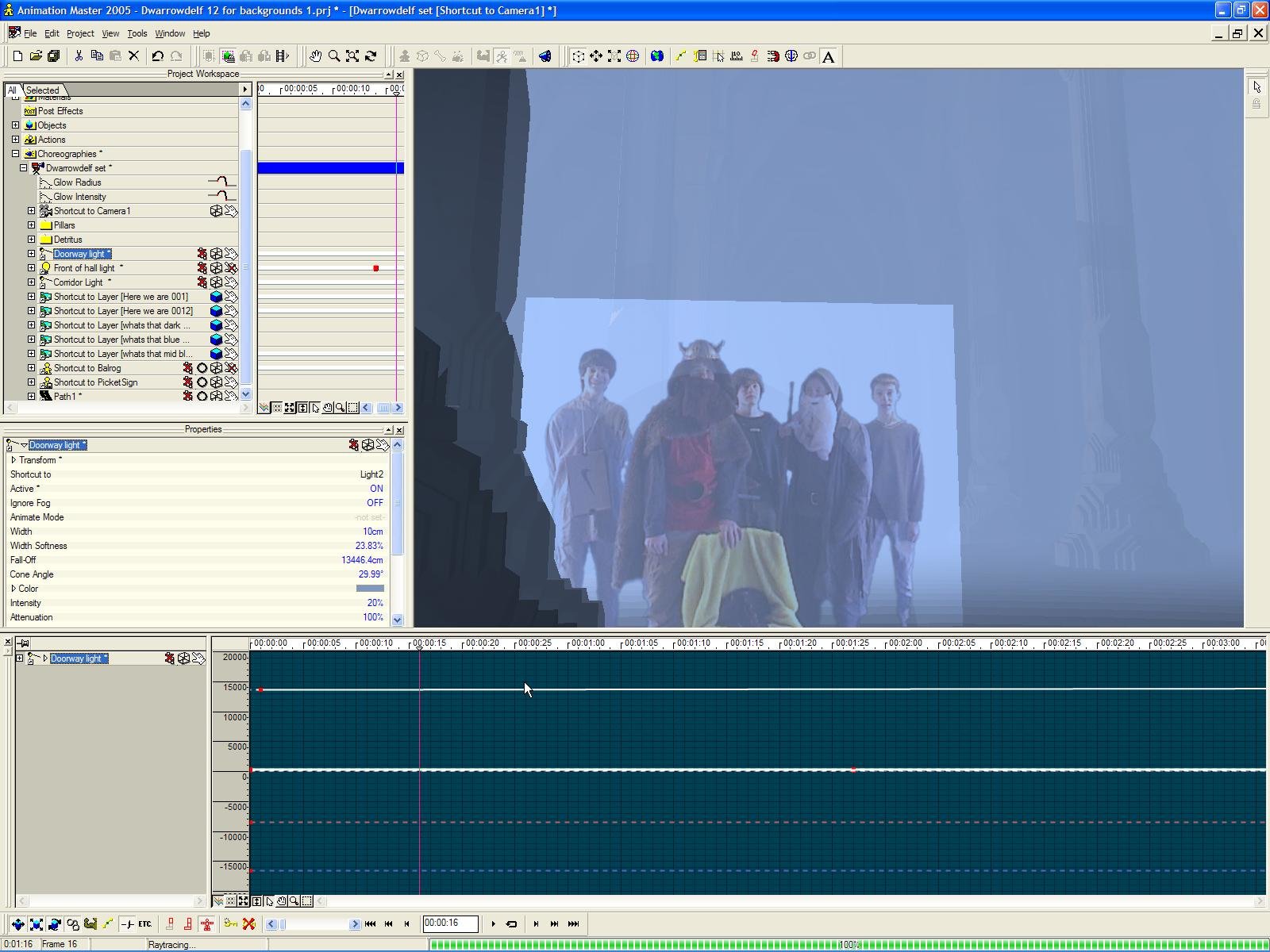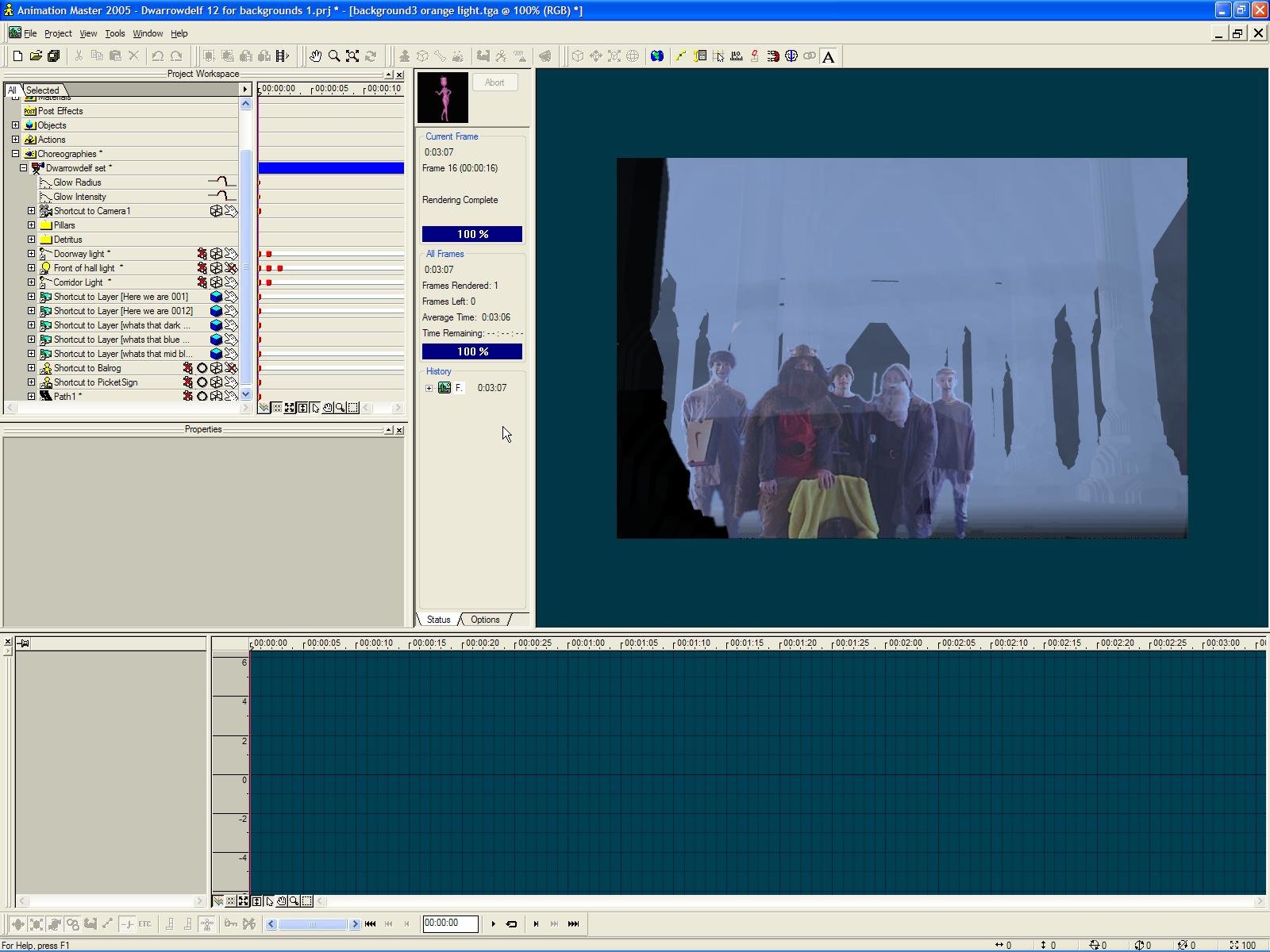
RoyBU
*A:M User*-
Posts
44 -
Joined
-
Last visited
Content Type
Profiles
Forums
Events
Everything posted by RoyBU
-
I have modeled a box and applied decals for a realistic look. When I brought it into a default chor it looked fine until I moved off frame 0, whereupon all the decals disappeared and the shading reverted to the plain, non-decaled look. So all frames after frame 0 fail to show my decals. Presumably there is a setting that needs to be changed. Could someone clue me in? Thanks.
-
Thanks for the tip. I looked up "composite" and "exr" in the help index and found the relevant page, but confess I don't understand it very well. Is there a tutorial somewhere that goes into more depth on this?
-
Yes, I've thought of doing that, and for a scene with a static camera I think that's the way to go. For this particular scene, however, the camera is going to be moving and the nice thing about staying in AM is I can do that and everything stays in proper perspective. Thanks for the suggestion.
-
OK, in getting a still ready to post I discovered that this problem does not appear in a final render, only in a shift-Q quick render. Below you can see the difference between the two (the one on the left is the quick render). I turned the intensity of the light way up to make the "problem" obvious. Too bad that quick render isn't a more accurate representation; 3-4 minutes is a long time to wait every time I want to see the result of a lighting tweak. [attachmentid=17043] [attachmentid=17044]
-
I have some live-action footage I am using in an animation. The footage used a green screen and in After Effects I eliminated the green to leave only the actors and an alpha channel. I imported the footage into AM as a TGA sequence. So far, so good. I want the footage to be lit by a klieg light that has volumetric turned on. The problem is that the volumetric effect is lighting up the transparent part of the footage somewhat brighter than background objects, so the actors appear to be in a rectangle that is unnaturally brighter than the surrounding scene. I don't understand what is causing the klieg light to (apparently) reflect off the transparent part of the footage, so I can't figure out how to stop it. I tried turning off shadows and reflections for my footage, but that made no difference. I welcome your suggestions. Thanks, Roy
-
OK, I'm glad to learn the proper procedure. I did try to go to the Reports area, but it required me to enter my nickname and password (even though I'm already logged in) and then claimed not to recognize me. Is a special account required for making reports?
-
I have been working on a scene with volumetric lights and wonder if I have discovered a small bug. Try the following: Open a new project, default choreography. Change the view/render mode to shaded. Turn off the KeyLight and FillLight. Position the Rim light so that the entire light and the beginning of its cone appear in the camera frame (something like x -125, y 180, z -30). Change the cone angle to something like 30 degrees. Reduce the falloff to around 600 cm. Change the camera background to black (so the effect is easier to see). (You can also place an object in the scene to confirm that shadows are in fact appearing, but it isn't necessary.) At this point, if you do a shift-Q for quick preview you should see the circle of light on the ground. Now turn on volumetric for this light. Quick preview should now be showing the cone of light as it passes through the air, but on my system (v.12t) it does not - I still see only the circle of light on the ground. Now turn "cast shadows" off for this light. Magically, the volumetric cone appears. If you turn shadows back on, the cone disappears. Now click on the "render animation preview" toolbar button and, with shadows ON, click in the chor to do a render. Once you get one frame done, it should correctly show both the shadows and the volumetric cone. Abort the render and now do a shift-Q quick render. Unlike before, it should now correctly show both the shadows and the volumetric cone. So it appears that after a render (with shadows on), the quick preview shows volumetrics properly when shadows are on. But if you now save your project, then reload it and do a quick render, once again the volumetric cone will only appear if shadows are turned off. You have to do a render again before the volumetrics will behave properly. I know my description is long, but it's actually very quick to carry out this experiment and I'd appreciate it if someone could confirm this behavior for me. It really drove me crazy when I was first starting to work with volumetric lighting and couldn't seem to get it to work. Roy
-
OK, now I'm even more confused. As I said in my above post, I rendered out a simple scene using volumetric (on a klieg light) and shadows and both worked as expected even though in quick render the volumetric did not show up. After posting the above, I went back to experimenting and discovered that now, post render, volumetric DOES show up in quick render. Wondering if I had changed a setting and not realized it, I opened another project (the one I'm actually trying to use volumetric in) and did a quick render. As before, volumetric did not show up even though it was on. Then I rendered one frame to disk and, as with my simple test project, volumetric appeared in the render. Then I went back to my choreography, did a quick render and - lo and behold! - now the volumetric shows up in quick render. However, after saving, exiting A:M, and then restarting and reopening my project, it's back to where I was before -- volumetric will only show up in quick render if shadows are turned off. Am I missing something here?
-
As a follow-up, I have been experimenting with lighting and thought I had discovered that volumetric would not work when shadows were turned on. In fact, I was doing a one-frame render to include as an attachment to a posting about this "problem" when I discovered that when I did the render-to-disk the volumetric DOES work with shadows, even though it would not show up in quick (shift-Q) render. So I am glad to finally understand this, but am left wondering why volumetric doesn't show up in quick render with shadows turned on.
-
Thanks, that thread is really helpful.
-
I am trying to get the effect of a light shining through a doorway into a very large dark room. The doorway won't be visible, but that seemed like the easiest way to change the light cone's shape from a circle to a rectangle. The problem I'm having is that if I turn volumetric on for the light, then the light rays are visible as they cut through the air in the dark room (which is what I want), but the doorway does not block any of the light. If I turn on shadows for the light, then the doorway blocks the light as I want but now the light cone is no longer visible. How do I get both shadows and volumetrics to work at the same time?
-
Yes, so far I like v12.0p very much. One strange thing -- when I loaded the Dwarrowdelf set in v12.0 the floor lost all its texture (just a solid color, and I did not notice this immediately). I figured out that the two images for the floor were for some reason not coming in with the project, so I specified those images again and then reset the repeats and it looks right again. I don't know why that would happen; I was loading straight from the CD. Now I also recollect that in v11.1 the program would ask me where the concgen image was when it was trying to load in that project. Don't know why that happened either, since the image was obviously on the CD.
-
Well, I uninstalled version 11.1b using the Windows uninstall utility from Control Panel. Then I reinstalled and tried again with the same result. (Actually, I let it go ahead and render all 300 frames because for some reason they were only taking a few seconds each, but the render did not complete because towards the end the program spontaneously exited to Windows.) I noticed that after the reinstall my settings had been retained (e.g., the Balrog scene came up the first time I ran A:M after the reinstall) so I suspect that a more complete uninstall would be needed and that something in the settings is messed up. (For future reference, it would be nice to know how to do a really complete uninstall of the program.) However, rather than hunt that down, I installed version 12.0p that I had downloaded some time ago and not installed yet. I loaded the Dwarrowdelf.prj into 12.0p and rendered a single frame as TGA no problem. Phew! I'll continue from here and thanks to all for your suggestions.
-
I am running 11.1b. I tried as suggest with the "Advanced" option unchecked, but it still starts rendering all frames. I had already saved the project to my hard disk and had loaded it from there. Not knowing what else to do, I will try updating to a later version of A:M and trying again. Thanks for the suggestions.
-
Hello all, I am trying to use the Dwarrowdelf set so generously donated by William Sutton, as found on the Hash2005 CD under data\models\sci-fi\balrog. I loaded the dwarrowdelf.prj file and tried to render out (to a file) one frame as a TGA. Although I specify the beginning and ending time as the first frame, the render nonetheless begins rendering all 300 frames. When I abort the process after waiting for one or two frames to have finished, I find that the resulting TGA files are basically empty and unreadable. By the way, I tried with both AVI and Quicktime and both of those also ignore my direction to only render a subset of all the frames. (In mucking around trying to figure this out, I discovered that there are output options listed under the Camera1 shortcut, but strangely, I can't change the format, filename, or resolution at all (the program allows me to click and select something else but then doesn't change what's displayed as the current option) and trying to change the frame range leads to unpredictable results. I can, on the other hand, change all these things for the Camera1 listed under Objects. As a beginner not understanding how all these places for the same options relate to each other, I don't know if these observations have any bearing on my problem.) As a test of my system, I did open a new project, dropped the KeeKat model in a choreography and rendered out one frame as a TGA without any trouble. The resulting file looks just fine in Paint Shop Pro. So it must be something about the Dwarrowdelf set, but I haven't been able to figure it out and don't know where else to look. I have viewed Sutton's brief movie clip using his Balrog in the Dwarrowdelf set, so obviously it worked for him. If someone could take a look or point me to a place that explains these matters further I'd very much appreciate it. Thanks, Roy Underhill









